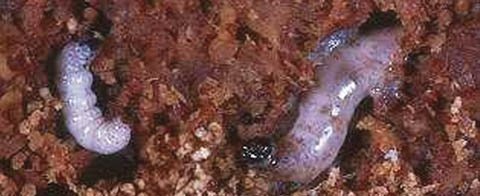With the news that codling moth has developed resistance to the granulovirus in organic apple orchards, U.S. orchardists who use the virus are encouraged to use resistance management strategies to keep the virus effective.
After growers in Europe reported that the virus was losing its effectiveness against the pest, German insect virologists and geneticists surveyed 13 orchards in southern Germany and tested samples. The scientists reported in a recent issue of Science magazine that the codling moths collected from the field could tolerate doses of granulovirus a thousand times higher than susceptible strains of codling moths reared in the lab. Genetic studies showed that the resistance could be transmitted to future generations via one of the sex chromosomes, which means that resistance can increase quickly.

“It’s certainly a wake-up call to anybody who needed waking up,” said Mike Dimock, technical director for Certis USA, which makes the Cyd-X formulation of the virus. “We have to keep an eye on it.”
Dimock said experience has shown that there is no such thing as a resistance-proof insecticide, whether it’s a biological product or a chemical. Bt (Bacillus thuringiensis) was the first biological insecticide that pests developed resistance to in the field, he said. “And it was in cases where growers were using Bt exclusively and applying it repeatedly. They found that after enough generations and enough selection, you would select for resistance.”
Rapidly
Dimock said what was surprising about the reports of resistance to the virus in Europe was how rapidly the resistance came on. The virus was used for a long time before growers suddenly began noticing it was not working. Though U.S. growers need to be vigilant, he feels that the danger of resistance is not as great because growers have a somewhat bigger tool box at their disposal in terms of pest controls than their counterparts in Europe.
Dr. Lerry Lacey, entomologist with the U.S. Department of Agriculture in Yakima, Washington, said he has not heard reports of resistance in Washington yet, but he feels that the industry should be looking at strategies to minimize the possibility.
The lab studies in Germany showed that a female codling moth larva needs only one copy of the resistance gene to be almost 100,000 times less susceptible to the virus.
“I think you could see that in real life if you had a situation where your resistance level was quite high and kept applying the virus needlessly,” Lacey commented.
Europe
The codling moth granulovirus was discovered in Chihuahua, Mexico, in 1963. It was registered as a pest control in Switzerland in 1988, in Germany in 1991, and in France in 1993. All the European products were derived from the Mexican strain.
Three products containing the virus are commercially available in North America today: Cyd-X from Certis USA (registered in 1995); Virosoft from Biotepp (registered in 2000); and finally Carpovirusine from the Sumitomo –Corporation of America (registered in 2001).
Cyd-X and Carpovirusine are the same strains as the European ones, but Biotepp’s strain originated in Canada, according to Don Thomson, who has worked for the Sumitomo Corporation and now consults for Biotepp.
He said the granulovirus is widely used in Europe, mainly by conventional orchardists. In 2006, the virus was used on about 250,000 acres of European orchards, of which less than 10 percent were organic.
Resistance has been reported in a small number of sites in Italy, Switzerland, France, and Germany, and all are organic, Thomson said. “There is no known resistance in conventional orchards, where most of the virus is used.”
Organic growers have been using the virus longer than conventional growers and they tend to use it multiple times during the season, he said, whereas conventional growers usually integrate the virus with conventional insecticides.
Conventional growers in France use the virus as a codling moth population management tool. The virus does not kill instantly. It takes five to ten days for a larva to die, and in the meantime, it can chew on the outside of the fruit, causing a sting. If codling moth pressure is high, they use conventional pesticides first and then the virus later in the generation, when the population is reduced and the potential for fruit damage is lower.
United States
Although use of the virus in the United States is much less widespread than in Europe, Thomson guesses that most organic apple growers have used it.
“I don’t think there’s any organic grower in Washington State who has not used it one or more times,” he said. “Their options are so limited.”
Increasing numbers of conventional growers in the United States are also using the virus. Lacey said it fits in a conventional pest management program as well as organic and can be a useful tool where there is resistance to Guthion (azinphos-methyl), or if the grower needs a product that that can be applied near streams or close to harvest.
Resistance is not a concern in conventional orchards yet, Thomson said.
“I think, right now, it’s only the organic growers who should be thinking about resistance management because they’re the ones who tend to use the virus a lot.”
In order to stave off resistance, organic growers would be wise to use a combination of tactics, such as mating disruption, oil, the virus, and spinosad, he said.
Dimock said the key is to not rely on a single mode of action. “I don’t think anybody has any specific recommendations—not the companies, or the universities, or the USDA—that differs from any other insecticide resistance or IPM (integrated pest management) program.”
The European scientists are now looking for strains of the granulovirus that can overcome the moth’s resistance. Thomson said Andermatt Biocontrol of Switzerland has found and developed a strain of the virus that is not prone to resistance and has provided good control of resistant moth populations.
“The question is, for how long?” he added.

Leave A Comment